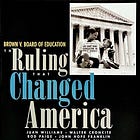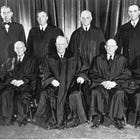Conversations: Ted Shaw
Now at UNC, former NAACP leader talks about the legacy of Brown v. Board
Theodore “Ted” Shaw won’t forget June 29, 2023.
That was the day the U.S. Supreme Court reversed affirmative action policies that allowed universities to consider a student’s race in admissions. Shaw, now the director of the Center for Civil Rights at the University of North Carolina at Chapel Hill’s law school, was lead counsel for the NAACP Legal Defense and Educational Fund when attorneys persuaded the high court to uphold the ruling in 2003.
“This is not a good day,” Shaw told WUNC after the most recent ruling. “In fact, I would describe it as one of the — another one of the — many historical betrayals over the centuries now by the Supreme Court when it comes to the interests and the status of African-Americans.”
Shaw, who was born in New York City six months after the court ruled unanimously in Brown v. Board of Education, has devoted his life to fighting for civil rights. He spent 23 years at the NAACP, including five years as the organization’s director-counsel and president, before moving into academia.
In 2004, as I worked on coverage of the 50th anniversary of Brown for American School Board Journal, I had an opportunity to speak with Shaw about his work with the NAACP and where he thought race relations stood then. It is interesting to read what he said then, especially given what has taken place since.
Here is the conversation:
How has the Brown decision affected you personally?
The Civil Rights Movement was the whole background and context of my early years. By the time I was in grade school, I was well aware of what was happening in the South with the sit-ins, the demonstrations, and the Freedom Riders.
My paternal grandmother worked as a domestic, cleaning white folks’ houses. I remember when she got up that morning to get on a bus to go to the March on Washington in August 1963. My grandmother wanted to take me, but I was living with my stepmother, and she didn’t let me go. I’ve always regretted that, but I understand her decision. I have a handbell my grandmother brought back from that march.
By the time I was in high school, I had become very active in student politics. The assassination of Martin Luther King Jr. in 1968 had a profound impact on the country and on me personally. After that, I knew I wanted to be a civil rights lawyer.
The strategy used to overturn segregation in U.S. public schools is widely credited with increasing equality and equity. Why was it so effective?
Brown was a consequence of many interests and many factors. Probably like any great event, its causes were not one-dimensional. The overall campaign to overturn Plessy v. Ferguson was brilliant, and I don’t think anyone can take anything away from the lawyers who litigated Brown.
Having said that, it’s important to put Brown into context. It came in the post-World War II era in which the United States had fought a war in Europe against the Nazis and their theories of racial superiority and eugenics that led to the Holocaust. The war was fought for a number of reasons, but that became the moral cause that was assigned to it.
You had black soldiers who once again found themselves fighting a war in the name of democracy who returned and found no democracy for themselves at home. You had the Cold War era with the United States struggling against communism and totalitarianism, and yet there was this glaring hypocrisy, which was segregation at home. It was an embarrassment for our nation.
Finally, you had the emerging nations in Africa and Asia that were putting an end to colonialism. All of those factors created a context in which Brown — if not inevitable — was certainly much more likely.
What is the legacy of Brown v. Board?
Brown changed the operating assumptions in America. Even though it didn’t get rid of segregation and discrimination, it broke the back of American apartheid and signaled the end of the end of the separate but equal era.
One thing about Brown that a lot of people misinterpret is exactly what it said. It did not overturn Plessy v. Ferguson except as it applied to segregation in public education, but Brown was followed by a series of Supreme Court decisions that overturned segregation with regard to public accommodations, such as swimming pools and restaurants. So while Brown didn’t overturn Plessy on all fronts, it was a spark for the entire Civil Rights Movement.
Brown divides American history into a kind of B.C. and A.D. Before Brown, the law explicitly sanctioned either slavery or segregation. After Brown, the 14th Amendment’s Equal Protection Clause was finally infused with some meaning and effect.
How successful have attorneys been at carrying out the intent of Brown and the other civil rights legislation that followed?
I believe deeply in the importance of the law. But I believe just as deeply that unless there’s a movement that creates a political context, a larger context in which the courts have a role to play that is informed by the larger context, you end up with litigation that is like a ship without water.
The civil rights litigation of the 1950s and ’60s was effective because of the whole social and political context of those times. We don’t have that social and political context today. In fact, it’s the conservatives, the people on the right, who have been most successful in terms of their movement. They have created the political conditions that then create an atmosphere that the judiciary has used to move in their direction lately. They haven’t been completely successful, but they’ve understood the importance of getting conservative judges on the courts and on the bench.
Part of that explains why we are where we are today. The federal courts have gratuitously adopted [laws] with regard to race that in general are very limited and very stingy. And that leaves much of the effects of the long history of segregation and discrimination intact and unreachable by law. Brown signaled the end of legally sanctioned discrimination. It didn’t end segregation.







